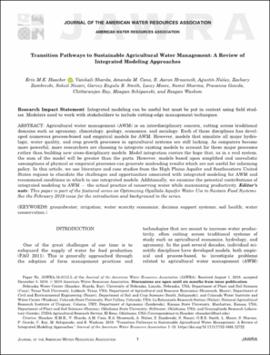| dc.contributor.author | Haacker, Erin M. K. | |
| dc.contributor.author | Sharda, Vaishali | |
| dc.contributor.author | Cano, Amanda M. | |
| dc.contributor.author | Hrozencik, R. Aaron | |
| dc.contributor.author | Nunez, Agustin | |
| dc.contributor.author | Zambreski, Zachary | |
| dc.contributor.author | Nozari, Soheil | |
| dc.contributor.author | Smith, Garvey Engulu B. | |
| dc.contributor.author | Moore, Lacey | |
| dc.contributor.author | Sharma, Sumit | |
| dc.contributor.author | Gowda, Prasanna | |
| dc.contributor.author | Ray, Chittaranjan | |
| dc.contributor.author | Schipanski, Meagan | |
| dc.contributor.author | Waskom, Reagan | |
| dc.date.accessioned | 2022-03-29T13:34:16Z | |
| dc.date.available | 2022-03-29T13:34:16Z | |
| dc.date.issued | 2019-02 | |
| dc.identifier | oksd_haacker_transitionpathways_2019 | |
| dc.identifier.citation | Haacker, E. M. K., Sharda, V., Cano, A. M., Hrozencik, R. A., Nunez, A., Zambreski, Z., ... Waskom, R. (2019). Transition pathways to sustainable agricultural water management: A review of integrated modeling approaches. Journal of the American Water Resources Association, 55(1), pp. 6-23. https://doi.org/10.1111/1752-1688.12722 | |
| dc.identifier.uri | https://hdl.handle.net/11244/335090 | |
| dc.description.abstract | Agricultural water management (AWM) is an interdisciplinary concern, cutting across traditional domains such as agronomy, climatology, geology, economics, and sociology. Each of these disciplines has developed numerous process-based and empirical models for AWM. However, models that simulate all major hydrologic, water quality, and crop growth processes in agricultural systems are still lacking. As computers become more powerful, more researchers are choosing to integrate existing models to account for these major processes rather than building new cross-disciplinary models. Model integration carries the hope that, as in a real system, the sum of the model will be greater than the parts. However, models based upon simplified and unrealistic assumptions of physical or empirical processes can generate misleading results which are not useful for informing policy. In this article, we use literature and case studies from the High Plains Aquifer and Southeastern United States regions to elucidate the challenges and opportunities associated with integrated modeling for AWM and recommend conditions in which to use integrated models. Additionally, we examine the potential contributions of integrated modeling to AWM - the actual practice of conserving water while maximizing productivity. Editor's note: This paper is part of the featured series on Optimizing Ogallala Aquifer Water Use to Sustain Food Systems. See the February 2019 issue for the introduction and background to the series. | |
| dc.format | application/pdf | |
| dc.language | en_US | |
| dc.publisher | Wiley | |
| dc.relation.ispartof | Journal of the American Water Resources Association, 55 (1) | |
| dc.rights | This material has been previously published. In the Oklahoma State University Library's institutional repository this version is made available through the open access principles and the terms of agreement/consent between the author(s) and the publisher. The permission policy on the use, reproduction or distribution of the material falls under fair use for educational, scholarship, and research purposes. Contact Digital Resources and Discovery Services at lib-dls@okstate.edu or 405-744-9161 for further information. | |
| dc.subject | 0406 Physical Geography and Environmental Geoscience | |
| dc.subject | 0905 Civil Engineering | |
| dc.subject | 0907 Environmental Engineering | |
| dc.subject | Environmental Engineering | |
| dc.title | Transition pathways to sustainable agricultural water management: A review of integrated modeling approaches | |
| dc.date.updated | 2022-03-28T21:02:43Z | |
| osu.filename | oksd_haacker_transitionpathways_2019.pdf | |
| dc.description.peerreview | Peer reviewed | |
| dc.identifier.doi | 10.1111/1752-1688.12722 | |
| dc.description.department | Plant and Soil Sciences | |
| dc.type.genre | Article | |
| dc.type.material | Text | |
| dc.subject.keywords | groundwater | |
| dc.subject.keywords | irrigation | |
| dc.subject.keywords | water scarcity economics | |
| dc.subject.keywords | decision support systems | |
| dc.subject.keywords | soil health | |
| dc.subject.keywords | water conservation | |
| dc.identifier.author | ORCID: 0000-0003-4836-4113 (Haacker, EMK) | |
| dc.identifier.author | ScopusID: 56660591800 (Haacker, EMK) | |
| dc.identifier.author | ScopusID: 55818287000 (Sharda, V) | |
| dc.identifier.author | ScopusID: 57208450282 (Cano, AM) | |
| dc.identifier.author | ScopusID: 57200326406 (Hrozencik, RA) | |
| dc.identifier.author | ScopusID: 57202070880 (Núñez, A) | |
| dc.identifier.author | ScopusID: 57197857865 (Zambreski, Z) | |
| dc.identifier.author | ScopusID: 57205491843 (Nozari, S) | |
| dc.identifier.author | ScopusID: 57205485341 (Smith, GEB) | |
| dc.identifier.author | ScopusID: 57205492672 (Moore, L) | |
| dc.identifier.author | ScopusID: 56528654900 (Sharma, S) | |
| dc.identifier.author | ScopusID: 15727794100 (Gowda, P) | |
| dc.identifier.author | ScopusID: 35610547200 (Ray, C) | |
| dc.identifier.author | ScopusID: 34972127100 (Schipanski, M) | |
| dc.identifier.author | ScopusID: 6507433355 (Waskom, R) | |
